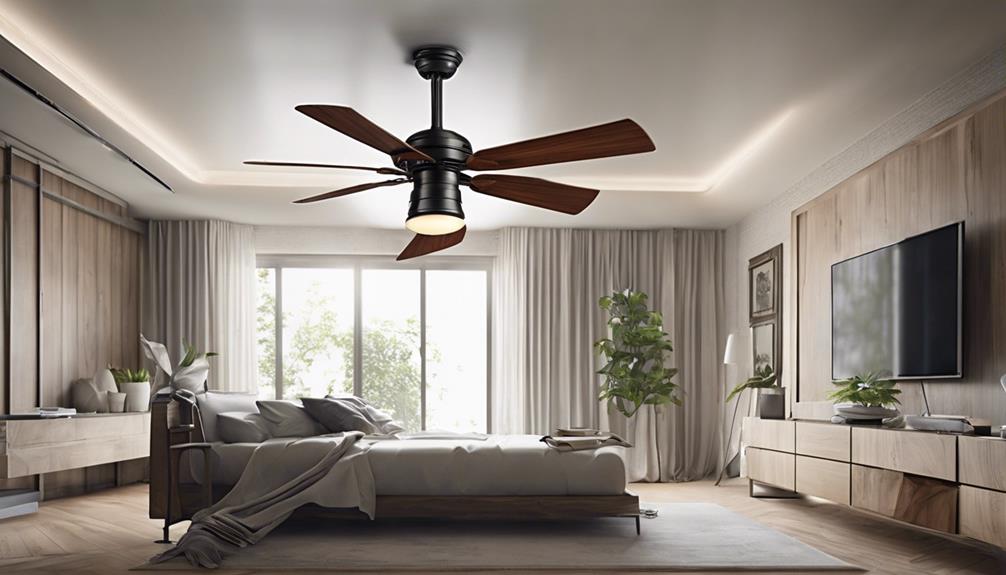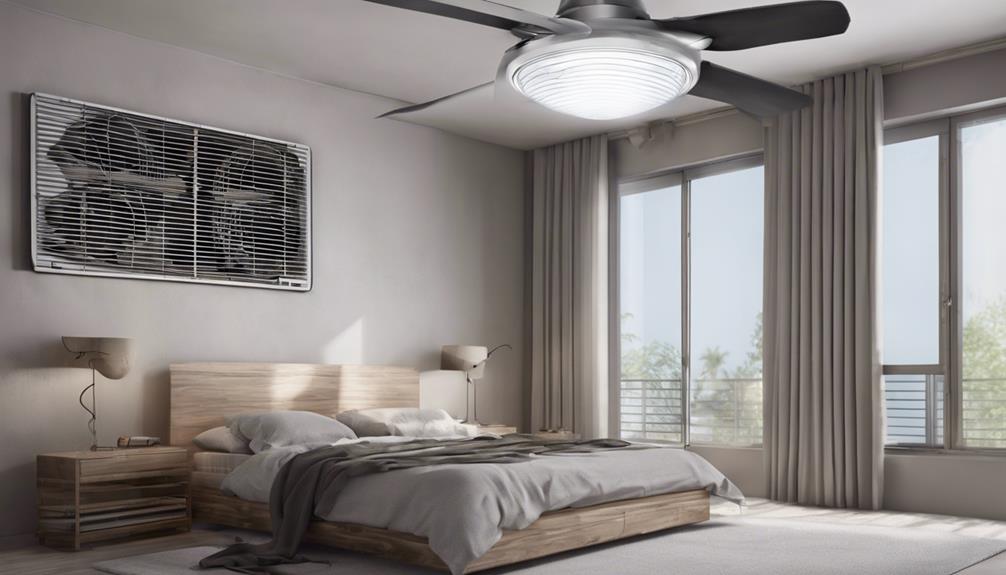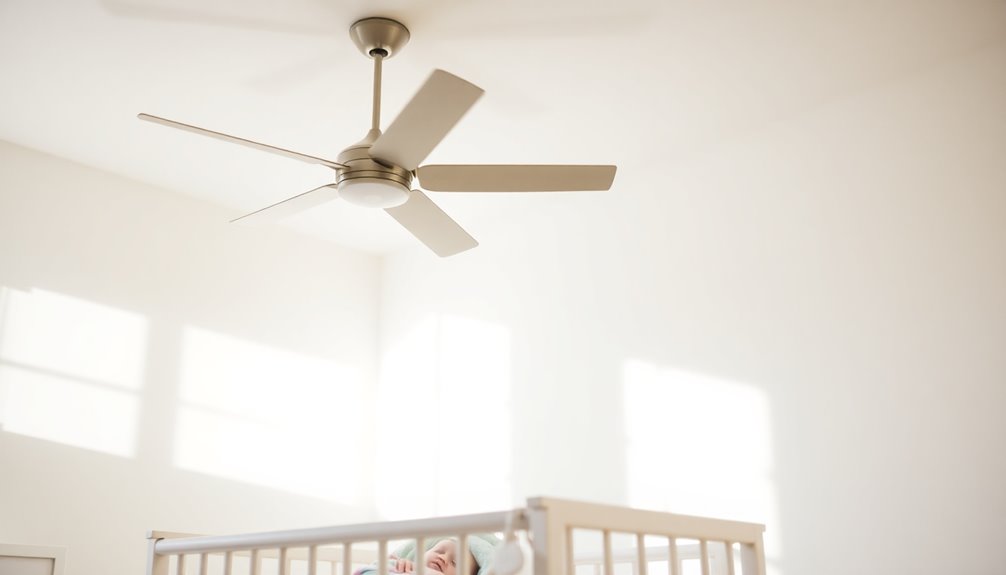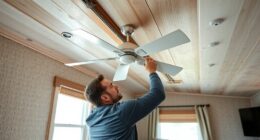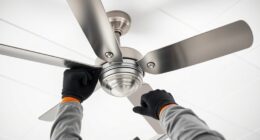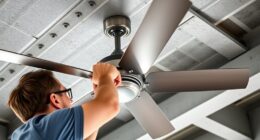Ceiling fans are effective in cooling your house as they create a refreshing breeze, enhancing comfort, and regulating room temperature. The wind chill effect generated by ceiling fans helps to maintain a cooler ambiance by moving air over your skin, offering a cost-effective cooling solution. If you're looking to learn more about optimizing your ceiling fan's efficiency to create the best cooling effect, keep exploring the benefits of using ceiling fans listed earlier.
Key Takeaways
- Ceiling fans create a refreshing breeze to cool your home.
- They help regulate room temperature for enhanced comfort.
- Ceiling fans reduce energy costs and save on utility bills.
- Properly sized fans can save up to 14% on AC costs.
- Fans optimize air circulation, reducing hot spots and maintaining consistent room temperature.
Benefits of Using Ceiling Fans
Using ceiling fans can significantly reduce your energy costs and enhance the comfort of your living space. Ceiling fans aren't only stylish additions to your home but also practical tools for saving money on cooling expenses. By using ceiling fans in conjunction with your air conditioning system, you can save 30 to 40 percent on your utility bills compared to running the AC alone. Opting for Energy Star labeled fans can provide even more energy savings, helping you to be more environmentally friendly while keeping your expenses in check.
Additionally, these fans can help decrease the amount of time your AC needs to run, further contributing to energy efficiency. Not only do ceiling fans help you save money, but they also offer a decorative touch to your rooms with their unique designs and lighting fixtures. Embracing ceiling fans as part of your home decor can bring both functional and aesthetic benefits, making your living space more comfortable and inviting year-round.
How Ceiling Fans Cool Your Home

Ceiling fans cool your home by creating a refreshing breeze that helps regulate room temperature and enhance comfort. When set to rotate counterclockwise in the summer, they create a wind chill effect, making you feel cooler by moving air over your skin. This movement also helps carry heat away from your body, further increasing comfort levels.
The counterclockwise rotation pushes cool air down towards the floor, improving the overall room temperature without actually lowering it. By using ceiling fans alongside your air conditioning, you can raise the thermostat setting a few degrees while still feeling just as cool, ultimately saving energy and reducing your utility bills.
The key function of ceiling fans is to circulate air effectively, making your space feel more comfortable without drastically changing the room's temperature.
Ceiling Fans for Better Air Circulation
Enhancing airflow within a room, properly sized and positioned ceiling fans can significantly improve air circulation. By effectively distributing cool air, ceiling fans help mix warm and cool air, reducing hot spots in your home. Ensuring your ceiling fan is set to the correct rotation is key to optimizing air circulation. When used alongside air conditioning, ceiling fans can enhance overall cooling efficiency, making your space more comfortable while potentially reducing the need for excessive air conditioning, thus improving energy efficiency.
Proper air circulation from a ceiling fan can help maintain a consistent room temperature, creating a more pleasant environment. This harmonious balance of cool air through the fan and proper airflow contributes to both comfort and energy savings. By strategically using your ceiling fan in conjunction with your air conditioning system, you can make your home a more comfortable and energy-efficient space.
Impact of Ceiling Fans on Cooling Costs

Ceiling fans play a crucial role in reducing cooling costs by allowing us to set our thermostats higher while still maintaining comfort. This simple adjustment can lead to significant savings on energy bills over time.
Cost Savings Analysis
Optimizing the use of ceiling fans in conjunction with air conditioning systems can lead to significant savings on cooling costs for homeowners. By following a few simple tips, you can maximize the cost-saving benefits of your ceiling fans:
- Using ceiling fans can save homeowners up to 14% on air conditioning costs.
- Raising the thermostat by 4°F with ceiling fan usage can result in significant energy savings.
- Millions of households could collectively save billions by optimizing ceiling fan usage for cooling.
- Properly sized and used ceiling fans can lead to approximately 12% savings on cooling costs.
- Running ceiling fans in conjunction with AC can help reduce overall cooling expenses.
Energy Efficiency Benefits
By strategically utilizing ceiling fans in conjunction with air conditioning systems, significant energy efficiency benefits can be achieved, ultimately leading to substantial savings on cooling costs for homeowners. The Department of Energy suggests that running ceiling fans in a counterclockwise direction during the summer can help air circulation and make you feel cooler. Energy-efficient ceiling fans, particularly those with an Energy Star label, can save you money by offering up to 40% more efficiency compared to standard models. This increased efficiency translates to lower utility bills, contributing to reduced energy consumption and overall savings on your cooling bill. Properly sized ceiling fans, set in the right direction, play a crucial role in enhancing cooling efficiency and decreasing energy expenses.
| Energy Efficiency Benefits |
|---|
| Counterclockwise direction helps with air circulation |
| Energy Star labeled fans offer up to 40% more efficiency |
| Savings of up to $30 monthly on cooling costs |
| Up to 14% reduction in air conditioning costs when used with AC unit |
Optimizing Ceiling Fan Efficiency

Maximizing the efficiency of a ceiling fan involves strategic placement and proper settings to enhance cooling effects while conserving energy.
- Ensure your ceiling fan is set to spin counterclockwise in the summer to create a refreshing cooling breeze.
- Consider raising your thermostat by up to 4°F when using a ceiling fan to save on energy costs without compromising comfort.
- Opt for Energy Star labeled ceiling fans, which can be up to 40% more efficient, helping reduce utility bills.
- Properly position your ceiling fan with blades at least 8 inches below the ceiling and 7-9 feet above the floor for optimal air circulation.
- Run your ceiling fan in occupied rooms to maximize its efficiency in creating a wind chill effect, potentially reducing the need for excessive air conditioning usage.
Ceiling Fans Vs. Air Conditioning

Ceiling fans and air conditioning serve different purposes in cooling a house.
While air conditioning systems lower the temperature of the air, ceiling fans create a breeze that makes you feel cooler by evaporating sweat on your skin.
Combining both can help maintain comfort while reducing energy costs.
Fan Efficiency Comparison
Comparing the efficiency of fans and air conditioning reveals significant cost savings and energy benefits. When it comes to cooling your home, opting for a ceiling fan over running central A/C can make a notable difference. Here are some key points to consider:
- Ceiling fans cost about 1 cent per hour to run, while central A/C costs around 43 cents per hour.
- Using ceiling fans can help reduce air conditioning costs by up to 14%.
- Energy-efficient ceiling fans can be up to 40% more efficient with an ENERGY STAR® label.
- Ceiling fans can allow you to raise your thermostat setting by up to 4°F without sacrificing comfort.
- Proper use of ceiling fans alongside air conditioning can lead to significant energy savings and efficiency.
Energy Cost Analysis
When considering the cost-effectiveness of cooling options, the energy savings associated with using ceiling fans versus central air conditioning are striking. Running a ceiling fan costs approximately 1 cent per hour, while central A/C can cost around 43 cents per hour.
By utilizing ceiling fans, you can increase your thermostat setting by up to 4 degrees, potentially saving up to $30 monthly on cooling costs. These energy-efficient fans not only reduce cooling expenses but also contribute to lower energy consumption.
Considerations for Ceiling Fan Installation

Considering the optimal height for installing a ceiling fan is crucial for efficient air circulation and cooling in a room. When installing a ceiling fan, make sure to adhere to the following considerations:
- Ensure the room has a minimum of an eight-foot ceiling for proper installation of the ceiling fan.
- Position the fan blades at least eight inches below the ceiling to optimize air circulation.
- Select the fan diameter based on the room size to achieve the most efficient cooling effects.
- Look for the Energy Star symbol on the fan for increased energy efficiency and cost savings.
- Adhere to installation guidelines provided by the Department of Energy for optimal performance and safety.
Frequently Asked Questions
Do Ceiling Fans Help in Extreme Heat?
In extreme heat, ceiling fans play a crucial role in maintaining comfort by aiding air circulation and temperature regulation. They enhance energy efficiency, provide cooling benefits, and promote electricity savings.
The constant air movement created by ceiling fans helps dissipate heat and reduce the reliance on air conditioning. Incorporating ceiling fans into your cooling strategy during extreme heat can lead to a more comfortable indoor environment while conserving energy.
How Effective Are Ceiling Fans for Cooling?
I find ceiling fans highly effective for cooling due to their energy efficiency and air circulation benefits.
They help maintain a comfortable temperature in my house during the summer, leading to significant savings on air conditioning costs.
The cooling effect of ceiling fans enhances the comfort level by promoting better air circulation and aiding in moisture evaporation from the skin.
Does Having Ceiling Fans on Help Ac?
Having ceiling fans on can definitely help your AC system work more efficiently. By improving air circulation and creating a wind chill effect, ceiling fans can assist in maintaining a comfortable temperature in the room.
This synergy between the fans and AC can lead to increased energy efficiency, allowing you to potentially raise the thermostat without sacrificing comfort. Ultimately, using ceiling fans alongside your AC can enhance overall cooling efficiency and save on energy costs.
Do Fans Actually Cool Down a Room?
Using a ceiling fan properly involves strategic fan placement, adjusting fan speed, and considering room size for optimal air circulation.
By mixing hot and cool air, fans can create a comfortable environment. Efficient use of fans helps in distributing heat evenly and maximizing energy efficiency.
Remember, fans cool people, not rooms, by creating a wind chill effect that makes you feel cooler.
Mastering these elements ensures the best cooling benefits from ceiling fans.
Are Ceiling Fans Effective for Cooling in Different Environments, Such as Offices?
Ceiling fans are easy ways to cool offices and various environments. They are effective in circulating air and creating a breeze, which can help cool down spaces. By adjusting the fan speed and direction based on the specific environment, ceiling fans can provide a cost-effective cooling solution.
Conclusion
In conclusion, ceiling fans are a great addition to any home for improving air circulation and potentially lowering cooling costs.
While they may not cool your house as effectively as air conditioning, they offer a more energy-efficient option.
By optimizing their efficiency and using them in conjunction with other cooling methods, you can create a comfortable and cost-effective environment in your home.
So, why not give ceiling fans a whirl and see the difference they can make?
